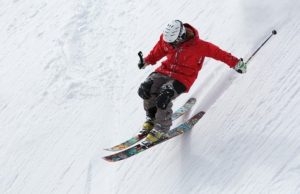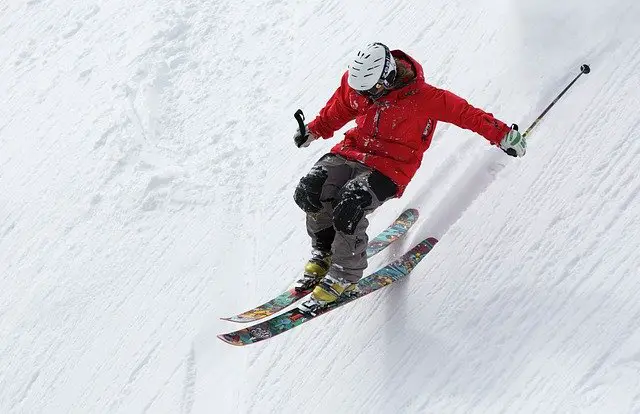Written By : Kelsey Downing, DPT
It’s almost ski season and you get some time to hit the slopes and have some fun. You are having a great day on the mountain, then you start to feel the first-day ‘noodle legs’. Your legs start to ache and every movement becomes strained, cutting your day short. By doing a few simple exercises and training in the offseason you may be able to avoid this scenario and get to fully enjoy that first day back on the slopes.
Common Causes of Knee Pain with Skiing
 Knee pain is the most common complaint with skiers, and oftentimes this pain can lead to serious injuries. This increase in knee pain is all due to the mechanics of skiing. When you maneuver down a slope, you are turning the leg while maintaining increased weight through the leg, increasing the torque and stress on the joint. If you do not have the strength and stability in the legs to maintain these mechanics you will be in for a sore day on the slopes. Knee injuries are one of many injuries that can occur on the mountain, but by taking the time to train your body before your season starts you can be more prepared and decrease your chance of injury with skiing.
Knee pain is the most common complaint with skiers, and oftentimes this pain can lead to serious injuries. This increase in knee pain is all due to the mechanics of skiing. When you maneuver down a slope, you are turning the leg while maintaining increased weight through the leg, increasing the torque and stress on the joint. If you do not have the strength and stability in the legs to maintain these mechanics you will be in for a sore day on the slopes. Knee injuries are one of many injuries that can occur on the mountain, but by taking the time to train your body before your season starts you can be more prepared and decrease your chance of injury with skiing.
It’s all in the Hips... and Knees... and Core
If you have decided to start a training program for your next ski season you may be wondering where to start and what to focus on. For any skier, it is important to build up the muscles in the hips, knees, and core for improved performance once the season starts. Here are some reasons why these areas should be a part of your list of exercises.
Starting with the Hips
The hips are crucial to skiing and preparing them for this sport is a must. The hips are responsible for controlling the rotation and movements of skiing as well as the alignment of the pelvis and lower extremity. This joint holds a lot of responsibility in how your day on the slope goes, so the stronger the better.
Moving onto the Knees
As stated earlier the knees are the most commonly injured joint in skiing. The mechanics of skiing put increased stress on the joint putting you at higher risk of Meniscus, ACL, and MCL injuries. Having increased stability in the knee will help tolerate these increased forces and possibly decrease your risk of injury.
Lastly the Core
The muscles of the core are very important in skiing. The core is not only a dominant player in balance and stability, but it is also a part of being a good skier. If you look at expert skiers you will notice very little movement in the upper body, keeping them stable on any terrain. Having the strength to maintain a solid trunk with the twists and turns of a complicated run is paramount.

The Best Strengthening Exercises for Skiing
Single-Leg Bridges
Start off lying down on a solid surface with your knees bent, then straighten out your right leg. Begin to push into your left heel and lift your hips off the ground, lifting your right leg off the ground as well. Engage your glutes as you come to the top and hold 3 seconds. Repeat 10-15 times and then do the other side.
Squats – with or without a Bosu Ball
The Best Bosu Ball Trainers for HomeBegin with your feet hip-width apart. Start to bend your knees and lower down like you were sitting in a chair. Your weight should be in your heels and your knees behind your toes. Go down as low as you can go while maintaining your mechanics and then slowly return back to standing. Repeat 20- 30 times. If you would like to add more of a challenge, try holding a weighted ball or standing on a BOSU ball to mimic skiing.
Planks
The good old plank is a great exercise to engage the core. Starting off on your forearms on the ground with your legs out straight. Start to press into your forearms and bring your torso off the floor. Engage your abdominal muscles and draw your belly button in towards your spine, aiming for a straight line from the head to the toes. Work your way up to a 1-minute hold.
Single-Leg Lowers
Starting on the floor with the legs extended. Keep the low back on the floor, start to bring your right leg up as high as you can, while hovering the left leg off the ground. Then with control alternate the legs. Alternate back and forth, using the core to control the movements. Complete 10 of these on each side.
Side-Steps With a Resistance Band
Start standing with feet shoulder-width apart and place a resistance band around your thighs. Keep feet far enough apart to maintain tension on the band. Start to walk sideways taking steps large enough to maintain the tension in the band. Do one direction for one minute and then another minute in the other.
Clamshells
Begin by lying on your right side with your knees bent to 90 degrees and your feet and hips stacked. Try to align your heels with your butt for the best position. Start to raise your left knee while keeping your feet together. Try not to rotate your hip or lift your right knee off the floor then return to start. Continue for a total of 20 repetitions and then repeat on the other side. If you would like to add some resistance try a resistance band tied above the knees for added difficulty.
Other Tips to Reduce Knee Pain With Skiing
Outside of exercise, there are some other things to keep in mind before you start your ski season.
- First is keeping a healthy weight. By keeping a healthy weight you decrease the strain on your body and your joints decreasing the chance of overuse injuries.
- The second is the proper gear. Gear can make a big difference in your skiing technique. Try heading to your local ski shop and talk to a professional to find the best fitting gear for your needs.
- Lastly, it all comes down to your technique. Great technique can make your days on the slope pain-free. Poor technique can lead to pain and possibly injury. Try talking to a ski professional and see if there is anything you can do to improve.
FAQ for Skiing with Knee Pain
Should I Wear a Knee Brace While Skiing?
A knee brace is a great way to stay on the slopes and reduce knee pain. Try and hold off on using a knee brace until you have to, that way your muscle stay stronger for longer. For the most support on the slopes, our favorite knee brace is the Shock Doctor Hinged knee brace
Can I Still Ski Moguls With Bad Knees?
Does Kinesiotape Work for Knee Pain With Skiing?
Kinesiotape is a good and safe way to reduce knee pain without the bulk of a brace. It’s simple, inexpensive, and can be effective for some people. That being said it may also not be enough support for the knees to do a full day of skiing. Our favorite type of kinesiotape is Rock Tape.
Does Skiing Cause More Arthritis in Knees?
No, it doesn’t speed up arthritis. Some activity and loading is actually beneficial for arthritic knees. That does come with a great of salt. If you try and ski double black diamonds all day then you could cause a lot of pain and inflammation, so be smart.
Can I Put Any Topical Pain Cream on my Knees for Skiing?
Sure, there isn’t a reason you can’t use Icy Hot, Bengay, Sombra, or any other topical pain cream to help you ski a little longer. The latest and greatest pain cream that just got approved is called Voltaren and is made specifically for arthritis.
Key Take Aways
Overall, take some time in your offseason to prepare your body and your mind for the season to come. By taking some small steps now you can greatly decrease your chances of pain and injury once your back on the slopes.
Written by: Kelsey Downing, PT, DPT
Kelsey Downing earned her Doctor of Physical Therapy (DPT) degree in 2016 from Campbell University in Buies Creek, NC. Since then, she has been working in a variety of settings. From outpatient, acute care, and home health she has gained a wealth of hands-on knowledge. Additionally, she has sought out further certification in manual therapy, concussion management, and lymphedema management. She continues to be driven to learn and refine her skills to improve patient care. Pt is a frequent contributor to physicaltherapyproductreviews.com.
References
Biggleston, G. “Ski conditioning for competitors.” DGWS Winter Activities. 12:5 (2001): 114-120.
Smith, R. “Pre-ski season preparation: conditioning and equipment.” Canada Family Physician. 29:7 (1983): 1909-1910.
Disclaimer: The information provided in this post is for educational purposes only. This is not a substitute for a medical appointment. Please refer to your physician before starting any exercise program.




